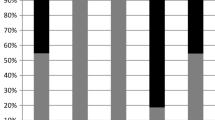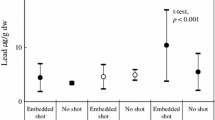Abstract
Many aquatic and terrestrial avian species inadvertently ingest lead (Pb) in the form of spent or fragmented ammunition, mistaking it for food or grit. Previous studies in our laboratory have shown that ingestion of even a single 45-mg pellet can significantly increase blood-Pb levels and significantly inhibit the enzyme delta aminolevulinic-acid dehydratase (δ-ALAD) for a period of greater than 4 weeks. In the current study, proven breeder pairs of domestic Roller pigeons were housed in individual cages. The hens were orally gavaged with dH2O vehicle, a single #9 Pb pellet (2.0 mm/45 mg) or a single #7.5 Pb pellet (2.3 mm/95 mg), placed back with the cock bird and allowed to mate for two consecutive clutches. The eggs were monitored for fertilization, shell damage, egg weight, and length during the 16- to 18-day incubation period. Hatchlings remained with the hen and cock through the weaning period (28–35 days post hatch) and were monitored for weight, development, and mortality. Weanling blood was collected for blood-Pb levels, δ-ALAD activity, red blood cell counts, total protein, and packed cell volume. Following euthanasia, weanling liver, spleen, kidney, sciatic nerve, thymus, and brain were collected for histopathology. Egg weight and length were significantly decreased in the #7.5 Pb pellet treatment group for the first clutch, and hatchling weight 7 days post hatch also was significantly less in the #7.5 Pb pellet treatment group during the first clutch. Histopathologic analysis showed increased lesions in liver, kidney, spleen, and thymus of the Pb-treated weanlings, during both the first and second clutch compared with the non-Pb-treated weanlings. These data suggest that maternal consumption of a single 95-mg Pb pellet can adversely impact egg size and hatchling organ development.

Similar content being viewed by others
References
Anders E, Dietz DD, Bagnell CR, Gaynor J, Krigman MR, Ross DW, Leander JD, Mushak P (1982) Morphological, pharmacokinetic, and hematological studies of lead-exposed pigeons. Environ Res 28:344–363
Barthalamus GT, Leander JD, McMillan DE, Mushak P, Krigman MR (1977) Chronic effects of lead on schedule-controlled pigeon behavior. Toxicol Appl Pharmacol 42:271–284
Bennett JR, Kaufman CA, Koch I, Sova J, Reimer KJ (2007) Ecological risk assessment of lead contamination at rifle and pistol ranges using techniques to account for site characteristics. Sci Total Environ 374(1):91–101
Berlin A, Schaller KH (1974) European standardized method for the determination of delta-aminolevulinic acid dehydratase activity in blood. Z Klin Chem Klin Biochem 12(8):389–390
Beyer NW, Spann JW, Sileo L, Franson CJ (1988) Lead poisoning in six captive avian species. Arch Environ Contam Toxicol 17(1):121–130
Binkowski LJ, Sawicka-Kapusta S, Szarek J, Strzyzweska E, Felsman M (2013) Histopathology of liver and kidneys of wild living Mallards Ans platyrhynchos and Coots Fulica atra with considerable concentrations of lead and cadmium. Sci Total Environ 450–451:326–333
Buerger TJ, Mirarchi RE, Lisano ME (1986) Effects of lead shot ingestion on captive mourning dove survivability and reproduction. J Wildlife Manage 50(1):1–8
Burger J, Gochfeld M (2004) Metal levels in eggs of common terns (Sterna hirundo) in New Jersey: temporal trends from 1971 to 2002. Environ Res 94(3):336–343
Cory-Slechta D, Garman RH, Seidman D (1979) Lead-induced crop dysfunction in the pigeon. Toxicol Appl Pharm 52:462–467
Craig JR, Rimstidt JD, Bonnaffon CA, Collins TK, Scanlon PF (1999) Surface water transport of lead at shooting range. Bull Environ Toxicol 63:312–319
Ferreyra H, Romano M, Beldomenico P, Caselli A, Correa A, Uhart M (2014) Lead gunshot pellet ingestion and tissue lead levels in wild ducks from Argentine hunting hotspots. Ecotox Environ Saf 103:74–81
Griffin TB, Couiston F, Wills H (1975) Biological and clinical effects of continuous exposure to airborne particulate lead. Arh Hig Toksikol 26:191–208
Haig SM, D’Elia J, Eagles-Smith C, Fair JM, Gervais J, Herring G, River JW, Schulz JH (2014) The persistent problem of lead poisoning in birds form ammunition and fishing tackle. Condor Ornithol Appl 116:408–428
Hanna-Attisha M, LaChance J, Sadler RC, Champney Schnepp A (2016) Elevated blood lead levels in children associated with the Flint drinking water crisis: a spatial analysis of risk and public health response. Am J Public Health 106(2):283–290
Holladay JP, Nisanian M, Williams S, Tuckfield RC, Kerr R, Jarret T, Tannenbaum L, Holladay SD, Sharma A, Gogal RM Jr (2012) Dosing of adult pigeons with as little as one #9 lead pellet caused severe δ-ALAD depression, suggesting potential adverse effects in wild populations. Ecotoxicology 21(8):2331–2337
Kendall RJ, Scanlon PF (1981) Effects of chronic lead ingestion on reproductive characteristics of ringed turtle doves Streptopelia risoria and on tissue lead concentrations of adults and their progeny. Environ Pollut A Ecol Biol 23(3):203–213
Kerr R, Holladay J, Holladay S, Tannenbaum L, Selcer B, Meldrum B et al (2011) Oral lead bullet fragment exposure in northern bobwhite (Colinus virgianus). Arch Environ Contam Toxicol 61(4):668–676
Lee J, Dietert RR (2003) Developmental immunotoxicity of lead: impact on thymic function. Birth Defects Res A Clin Mol Teratol 67(10):861–867
Lee J, Naqi SA, Kao E, Dietert RR (2001) Embryonic exposure to lead: comparison of immune and cellular responses in unchallenged and virally stressed chickens. Arch Toxicol 75:717–724
Locke LN, Bagley GE, Irby HD (1966) Acid-fast intranuclear inclusion bodies in the kidneys of mallards fed lead shot. Bull Wildlife Dis Assoc 2(4):127–131
Mateo R, Beyer WN, Spann J, Hoffman D, Ramis A (2003) Relationship between oxidative stress, pathology, and behavioral signs of lead poisoning in Mallards. J Toxicol Environ Health A 66(17):1371–1389
Matero R (2009) Lead poisoning in wild birds in Europe and the regulations adopted by different countries. Ingestion of lead from spent ammunition: implications for wildlife and humans. The Peregrine Fund, Boise, Idaho
Needleman HL (2000) The removal of lead from gasoline: historical and personal reflections. Environ Res A 84:20–35
Pain DJ, Fisher IJ, Thomas VG (2009) A global update of lead poisoning in terrestrial birds from ammunition sources. Ingestion of lead from spent ammunition: implications for wildlife and humans. The Peregrine Fund, Boise, Idaho
Pant N, Upadhyay G, Pandey S, Mathur N, Saxena DK, Srivastava SP (2003) Lead and cadmium concentration in the seminal plasma of men in the general population: correlation with sperm quality. Reprod Toxicol 17:447–450
Peddicord RK, LaKind JS (2000) Ecological and human health risks at outdoor firing range. Environ Toxicol Chem 19:2602–2613
Rabinowitz MB, Wetherill GW, Kopple JD (1976) Kinetic analysis of lead metabolism in healthy humans. J Clin Invest 58:260–270
Taggart MA, Green AJ, Mateo R, Meharg AA (2008) Metal levels in the bones and livers of globally threatened marbled teal and white-headed duck from El Hondo, Spain. Ecotox Environ Saf 72(1):1–9
Tsipora N, Burger J, Newhouse M, Christian J, Gochfeld M, Mizrahi D (2011) Lead, mercury, cadmium, chromium, and arsenic levels in eggs, feathers, and tissues of Canada geese of the New Jersey Meadowlands. Environ Res 111:775–784
Vallverdú-Coll N, Lopez-Antia A, Martinez-Haro M, Ortiz-Santaliestra ME, Mateo R (2015a) Altered immune response in mallard ducklings exposed to lead through maternal transfer in the wild. Environ Pollut 205:350–356
Vallverdú-Coll N, Mougeot F, Ortiz-Santaliestra ME, Rodriguez-Estival J, López-Antia A, Mateo R (2015b) Lead exposure reduces carotenoid-based coloration and constitutive immunity in wild mallards. Environ Toxicol Chem 35(6):1516–1525
Vallverdú-Coll N, Ortiz-Santaliestra ME, Mougeot F, Vidal D, Mateo R (2015c) Sublethal Pb exposure produces season-dependent effects on immune response, oxidative balance and investment in carotenoid-based coloration in red-legged partridges. Environ Sci Technol 49(6):3839–3850
Vallverdú-Coll N, Mougeot F, Ortiz-Santaliestra ME, Castano C, Santiago-Moreno J, Mateo R (2016) Effects if lead exposure on sperm quality and reproductive success in an avian model. Environ Sci Technol 50(22):12484–12492
Vigeh M, Smith DR, Hsu PC (2011) How does lead induce male infertility? Iran J Reprod Med 9(1):1–8
Wang H, Li S, Teng X (2016) The antagonistic effect of selenium on lead-induced inflammatory factors and heat shock proteins mRNA expression in chicken livers. Biol Trace Elem Res 171:437–444
Acknowledgments
The authors thank Danny Joe Humphrey for selecting and supplying the mating pairs of birds for this study. They also thank Brent Lovern, Rose Hill, and all of the animal care workers at the University of Georgia Poultry Diagnostic and Research Center for the care of the birds. This study was funded by a Grant provided by the Department of Defense, U.S. Army Institute for Public Health.
Author information
Authors and Affiliations
Corresponding author
Rights and permissions
About this article
Cite this article
Williams, R.J., Tannenbaum, L.V., Williams, S.M. et al. Ingestion of a Single 2.3 mm Lead Pellet by Laying Roller Pigeon Hens Reduces Egg Size and Adversely Affects F1 Generation Hatchlings. Arch Environ Contam Toxicol 73, 513–521 (2017). https://doi.org/10.1007/s00244-017-0406-9
Received:
Accepted:
Published:
Issue Date:
DOI: https://doi.org/10.1007/s00244-017-0406-9




